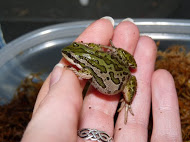The effects of hydropattern and predator communities on amphibian occupancy
http://www.nrcresearchpress.com/doi/abs/10.1139/cjz-2014-0106?src=recsys&#.VElKLzZlBpg
Abstract/Summary
Complex, interactive ecological constraints regulate species distributions, and understanding these factors is crucial for predicting species persistence. We used occupancy analysis, which corrects for imperfect detection, to test the importance of abiotic and biotic habitat and landscape factors on probability of occupancy by boreal chorus frog (Pseudacris maculata; Agassiz 1850) tadpoles. We hypothesized that hydropattern and predators are primarily important as they affect desiccation and predation risk and can interact in ways difficult to predict. We surveyed 62 wetland sites across an elevational gradient in Colorado, USA and modeled patterns in P. maculata occupancy. Tadpoles were most frequently present in intermediate hydropattern systems with lower desiccation risk and no predatory fish due to occasional drying. P. maculata occupancy had a strong negative relationship with fish presence while tadpoles, odonate larvae and tiger salamanders (Ambystoma mavortium; Baird 1850) frequently co-occurred. Dry seasonal conditions will likely result in fewer intermediate hydropattern ponds available for amphibian breeding. We hypothesize that this will force P. maculata to breed in habitats with fish. As habitats shrink, predators that co-occur with P. maculata are expected to concentrate in the remaining habitat and increase predation risk for developing tadpoles (assuming predators are similarly constricted in their habitat use as amphibians are).
Publication details
| Published Date: | 2014-09-23 |
| Outlet/Publisher: | Canadian Journal of Zoology |
| Media Format: | URL |
ARMI Organizational Units:
Rocky Mountains, Southern - BiologyTopics:
Species and their EcologyStressors
Water
Place Names:
ColoradoKeywords:
life historyoccupancy

